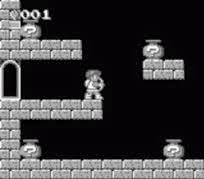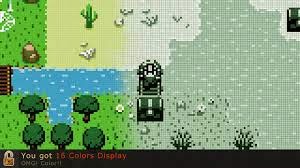As luck would have it, the amount of time between when I last played the first Kid Icarus and when I played Kid Icarus: Of Myths and Monsters is about the same as the amount of time between when they were released, which puts me in an unusually accurate frame of mind for reviewing such a classic sequel. The original Kid Icarus was one of the first NES games I had, and I played it enough that I can still hum the theme music on cue. Kid Icarus: Of Myths and Monsters was a game that I was originally excited about when I first read in a classic issue of Nintendo Power that it was coming out, but for whatever reason I didn't get around to actually playing it until recently. Better two decades late than never I suppose!
Kid Icarus: Of Myths and Monsters has a lot in common with the original game. In a way, it could be seen as a way to provide a portable version of the game while improving on some issues, rather than an attempt to expand the series. Both games combine vertical scrolling climbing levels, Metroid style maze-like dungeon levels, and the more traditional left to right side scrolling platforming levels that were once the industry standard. Every other level is a maze level that ends in a boss battle. Defeating the boss earns you one of the three magical items needed to save the world, but unlike in a Zelda or Metroid game, you don't get to equip these items until the last level when you have them all, and the game becomes more of a Gradius/R-Type style side scrolling shooter.
There were many improvements over the original Kid Icarus in Of Myths and Monsters. Despite being in a black and white grey scale, the graphics are much more detailed in this Gameboy release, especially the backgrounds which were simply solid black in the NES release in a classic arcade style. The vertical scrolling areas in the original let you run off one side of the screen and pop into the other side Pac-Man style, but if you fell off the bottom of the screen it was instant death, even though you were just down there a second ago and it was perfectly safe then. In the vertical scrolling areas of this sequel, the screen smoothly scrolls left and right with you as well, allowing the area to loop on itself creating the illusion of the game having much larger areas than it actually does, especially in parts that have mostly diagonal travel. As you fall, the screen scrolls down to follow your descent allowing you to safely backtrack to earlier areas in case you missed the entrance to one of the many bonus rooms.
The setting for the Kid Icarus series is an interesting one. Judging by the name and the scenery, the assumption is that like God of War, Kid Icarus must be set firmly in the world of ancient Greek mythology, but that's not actually the case. Even though there are references to Zeus and Medusa, and the lead character Pit bears a striking resemblance to the titular Icarus (who doesn't appear in either game by the way), the games are not actually set in ancient Greece, simply inspired by it. These games take place in an imaginary world called Angel Land. The instruction manuals (remember those?) for the games fill in the story of Angel Land being under attack, and Queen Palutena sending Pit to save the day. These plots are barely hinted at in the actual games, and even though the circumstances are different between the two releases, they are basically interchangeable, and if you've played one of the games, you've mostly played the other. Not that it's necessarily a bad thing. As much as I loved the original Metroid, the many changes made in Metroid: Zero Mission make for a much improved experience, and in that same way Kid Icarus: Of Myths and Monsters could be seen as an improved (minus the color) re-imagining of the original Kid Icarus, which was already feeling pretty dated by early 90s standards.
If I have to gripe about something in this game it's the music. The music isn't actually bad, it's actually rather pleasant and fits the game well, it just isn't nearly as memorable as the music in the NES original. It's not a matter of the Gameboy sound chip being less powerful either, the melodies simply don't grab me. Now part of that may be the fact that I was hearing these for the first time, while the original music I've been hearing since I was a kid, but I simply liked the first game's music better. Luckily, the original game's theme does make a return at the end of the game, so maybe that will inspire you to play through to the end?
Overall, I'm glad that I finally got around to playing Kid Icarus: Of Myths and Monsters. Even though I enjoyed it, I probably can't recommend it to everybody. Even in 1991 it wasn't an amazing game, and the black and white graphics might be a turn off for some modern gamers who've never even seen an original Gameboy. But, if you're a hardcore retro gamer who's up for some old school platforming fun and you've missed out on this game as I had for so many years, it's a solid classic game well worth jumping into and spending an hour or two.











.jpeg)


.jpeg)







.jpeg)





.jpeg)






.jpeg)



.jpeg)
